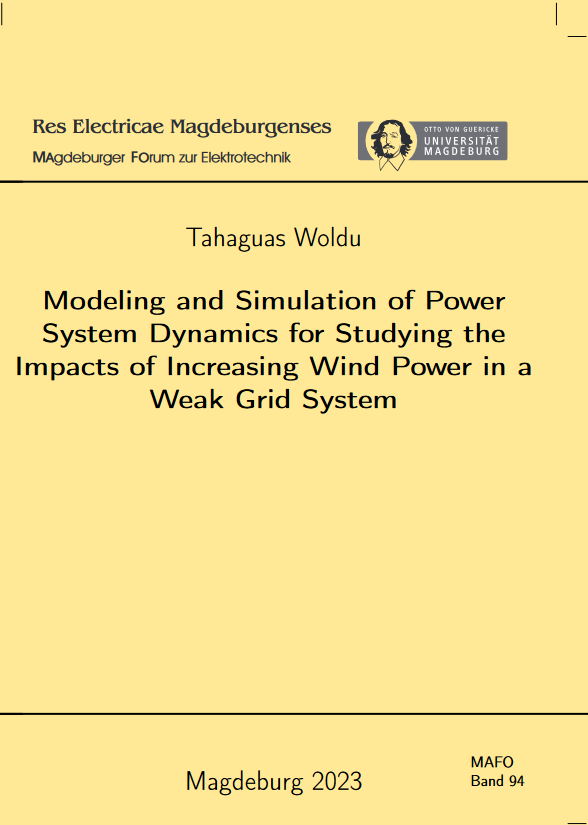Modeling and simulation of power system dynamics for studying the impacts of increasing wind power in a weak grid system
DOI:
https://doi.org/10.24352/UB.OVGU-2023-013Keywords:
Regenerative Energieformen, Alternative Energieformen, Wind energy, Electric power generation, Doubly-fed induction generator, STATCOMAbstract
The issue of environmental concerns and efforts to decrease dependency on fossil fuel are bringing renewable energy resources to the mainstream of electric power generation. Wind energy has undergone fast expansions worldwide in recent decades, but it also results in challenges in system operation related to frequency and voltage stabilities. Investigating and evaluating the impact of large-scale wind power on power system dynamics is an essential step to enhance the stable operation of frequency and voltage. This thesis work is intended to investigate the impacts of wind power and propose mitigation measures to enhance the dynamic behaviors of power systems with various network topologies. Doubly-fed induction generator (DFIG) is the most common wind turbine type due to its ability to operate at variable wind speed, partial-load converter and its capability to sustain the generator in synchronism with the system during abnormal conditions. Therefore, in this thesis work, a detailed model of DFIG-based wind turbine generators is employed to illustrate the influence of increasing wind power share in a large network system. The network dynamic models include synchronous generators, automatic voltage regulators, turbine-governor systems, DFIG-based wind turbine generators, various control elements, transmission systems and transformers. The mathematical dynamic models are solved using numerical integration techniques. For this purpose, a power system dynamic simulation tool is developed in the MATLAB/Simulink environment. In this thesis work, four test networks, including a case study for the Ethiopian power system, are employed to simulate the dynamic responses in different network topologies. The various simulation scenarios and network topologies confirm that an increase in wind power share deteriorates the transient stability of a system. The results effectively show that the increase in wind power penetration level has contributed to reducing the dynamic voltage stability margins, increasing the rate of change of frequency and reducing active power transfer capability. Moreover, the DFIGs are observed to disconnect themselves from the grid in response to grid voltage dips under severe fault events so as to protect the back-to-back rotor-side converters from rotor over-currents. The dynamic impacts of DFIG-based wind generators are assessed and control strategies are proposed to help them not only to remain connected but also to support the system stability during grid fault events. A new control strategy is contributed to enhance the low voltage ride-through capability of DFIG-based wind generators. The proposed control strategy comprises a joint application of a STATCOM and rotor over-speeding schemes. The STATCOM is mainly employed to improve the stator voltage dip and the rotor overspeeding strategy is employed to reduce the rotor over-currents during stator voltage dips that results in reduced output power. The over-speeding scheme is initiated to adjust the active power reference to be proportional to the voltage dip at the terminal. Thus, the turbine is made to increase the rotor speed till the maximum allowable limit so that the output power remains reduced until the stator voltage dip is recovered by the fast-acting STATCOM. The second contribution is related to solutions to the grid frequency challenges with higher penetration level of wind power. A new approach is introduced by which wind power plant operators can schedule their wind power generations so as to give support in the frequency restoration process. The proposed frequency control module at plant level monitors the contribution of various operating units in a large wind farm, based on their respective wind speed and the grid frequency deviation. The time-domain simulation results indicate that the proposed voltage and frequency control strategies are efficient to regulate the real-time voltage dip and enhance the voltage and frequency controllability with higher penetration level of wind power.
Downloads
Published
Issue
Section
License
Copyright (c) 2023 Res Electricae Magdeburgenses. Magdeburger Forum zur Elektrotechnik

This work is licensed under a Creative Commons Attribution-ShareAlike 4.0 International License.

